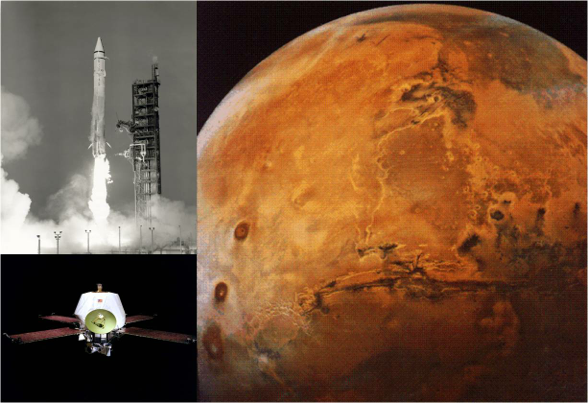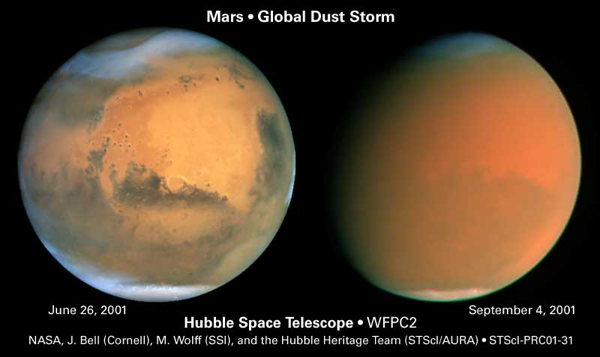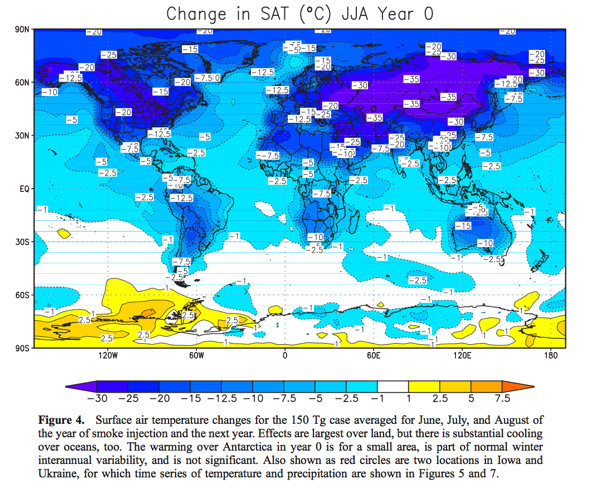Saturday - March 31, 2012
The Aesthetics of the Scientific Depiction of State-Inflicted Megadeath I
The Aesthetics of the Scientific Depiction of State-Inflicted Megadeath I.
[See Part II of this essay].
It has been 41 years since the Mariner 9 spacecraft went into orbit around Mars (September 1971). One of the planetary scientists who was active in this and other programs to explore the planets was Carl Sagan (1934-1996). In an example of scientific serendipity the scientists noticed that Mars was engulfed in a huge dust storm which threatened to limit the ability of the orbiting spacecraft to photograph the surface of Mars. A consequence of the dust cloud which enveloped the planet was that the surface temperatures on Mars dropped dramatically because the high level dust particles in the atmosphere blocked sunlight from reaching the surface. It led to Sagan wondering whether something similar would happen on earth if a nuclear war broke out between the superpowers causing massive fire storms in the cities (as had happened in Dresden and other German cities bombed by the Allies in WW2) which would pump huge amounts of soot and ash into the upper atmosphere.

Some 12 years later Sagan and a small group of atmospheric physicists came to the conclusion that something similar might happen on earth if even a "moderately" sized nuclear exchange took place on earth (a hundred or so thermonuclear weapons). They termed the climatic consequences on a nuclear war-created dust cloud which circled the earth and dramatically lowered surface temperatures and thus shortened the growing season for crops, as a "nuclear winter". Sagan co-authored a paper in Science in December 1983 which first brought this possibility to world attention (the so-called "TTAPS" paper authored by Turco, Toon, Ackerman, Pollack, and Sagan).

The implication of their work was that the use of nuclear weapons, even if as an act of "self-defense" or retaliation, would be suicidal for any party which used them - aggressor or victim alike. The drastic shortening of the crop growing season cause by the nuclear winter effect on climate would cause the deaths of tens of millions, perhaps hundreds of millions of lives. People would either freeze or starve to death in the years it would take for the dust and soot to be washed out of the atmosphere.
The nuclear winter hypothesis was not welcomed by the states which possessed nuclear weapons because it undermined the very reason for having them, let alone using them for "defensive" purposes. The vested interests who benefited from researching, building, and deploying nuclear weapons were /are so powerful that it is hard to imagine them ever voluntarily agreeing to give them up. When the cold war ended with the collapse of the Soviet Union and when significant cuts were made to the nuclear arsenals of the superpowers, the nuclear winter hypothesis was conveniently forgotten.

In 2007 the hypothesis was revisited using the latest climate modeling and the results are not encouraging. [See the paper by A. Robock, L. Oman and G. Stenchikov, “Nuclear Winter Revisited with a Modern Climate Model and Current Nuclear Arsenals: Still Catastrophic Consequences” (2007)]. The latest models (developed to model climate change and global warming) show that the effects of the nuclear winter would last longer than people had realized using the earlier modeling. What struck me when reading this paper was not so much the horror of what a nuclear exchange would cause in the destruction of life and property of innocent non-combatants world-wide (that has been obvious for decades), but that it could be and has to be described in the cold and calculating language of science. The mathematics is heartless and it is quite proper for scientists to use it. They also graphically show the results of their findings in charts and graphs to make them more understandable. It stuck me that these graphs and charts and pictures were eerily artistic and aesthetic in their own cruel way. And that is what I want to highlight below by showing some of the most "artistic" images from the Robock, Oman and Stenchikov paper.
Bibliography.
Most recent articles:
For Nuclear Security Beyond Seoul, Eradicate Land-Based 'Doomsday' Missiles by David Krieger and Daniel Ellsberg, March 27, 2012. At the Nuclear Age Peace Foundation <http://www.wagingpeace.org/articles/db_article.php?article_id=351>
Classic papers on the nuclear winter hypothesis
1982 AMBIO: Crutzen P., Birks J. (1982). "The atmosphere after a nuclear war: Twilight at noon". Ambio 11 (2): 114–25. JSTOR 4312777
TTAPS: R. P. Turco, O. B. Toon, T. P. Ackerman, J. B. Pollack, and Carl Sagan (23 December 1983). "Nuclear Winter: Global Consequences of Multiple Nuclear Explosions". Science 222 (4630): 1283–92. doi:10.1126/science.222.4630.1283
P. J. Crutzen, J. W. Birks, Ambio 11, 114 (1982); R. P. Turco et al., Science 222, 1283 (1983); V. V. Aleksandrov, G. L. Stenchikov, On the Modeling of the Climatic Consequences of the Nuclear War: Proceedings on Applied Mathematics, Computing Center, USSR Academy of Sciences, Moscow (1983).
C. Sagan, Foreign Affairs, 62, 257 (1983/84).
The Cold and the Dark: The World after Nuclear War: Conference on the Long-Term Worldwide Biological Consequences of Nuclear War (Washington, D.C.) 31 October 1983.
Recent updates of the "nuclear winter" hypothesis using the latest climate modeling:
A. Robock, L. Oman and G. Stenchikov, “Nuclear Winter Revisited with a Modern Climate Model and Current Nuclear Arsenals: Still Catastrophic Consequences,” Journal of Geophysical Research – Atmospheres, Vol. 112, No. D13, 2007. Retrieved from http://climate.envsci.rutgers.edu/pdf/RobockNW2006JD008235.pdf
S. Starr, “Catastrophic Climatic Consequences of Nuclear Conflict,” International Commission on Nuclear Non-Proliferation and Disarmament, December 2009. Retrieved from http://icnnd.org/Documents/Starr_Nuclear_Winter_Oct_09.pdf
<http://en.wikipedia.org/wiki/Nuclear_Winter>
